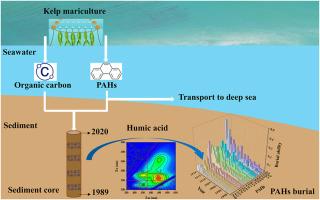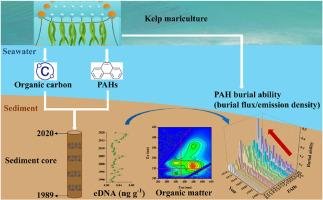海带养殖提高了多环芳烃的埋藏能力:来自中国爱连湾的证据
IF 7.3
2区 环境科学与生态学
Q1 ENVIRONMENTAL SCIENCES
引用次数: 0
摘要
海带养殖在固碳中起着重要作用。沿海沉积物掩埋是降低有机污染物风险的重要途径。然而,海带诱导的碳动态对有机污染物埋藏的影响在很大程度上仍然未知。本研究通过对中国爱连湾海水养殖基地的研究,证明了长期海带(Saccharina japonica)海水养殖增强了沿海沉积物中16种优先多环芳烃(PAHs)的埋藏能力(埋藏通量/排放密度)。利用沉积物岩心中海带环境DNA (eDNA)重建了爱莲湾海带养殖的历史生产。1989 ~ 2020年,海带eDNA含量从0.02±0.01 ng g-1增加到0.06±0.01 ng g-1 (p <;0.05),表明海带养殖在这一时期有所扩大。艾莲湾沉积物岩心总有机碳(TOC)在16.1 ~ 24.0 mg g-1之间变化。爱莲湾多环芳烃的平均埋藏能力在0.01±0.02 ~ 0.10±0.10之间。1989 ~ 2020年,海带养殖规模的扩大提高了TOC和顽固性腐殖酸样碳组分的含量,促进了多环芳烃(除萘、芴、蒽和二苯并[a,h]蒽外)的埋藏能力。海带养殖活动对低分子量多环芳烃埋藏能力的影响大于对高分子量多环芳烃埋藏能力的影响。本文章由计算机程序翻译,如有差异,请以英文原文为准。


Kelp mariculture enhances the burial ability of polycyclic aromatic hydrocarbons: Evidence from Ailian Bay, China
Kelp mariculture plays an important role in carbon sequestration. Burial by coastal sediments is an important way to reduce the risk of organic contaminants. However, the influences of kelp mariculture-induced carbon dynamics on the organic contaminant burial remain largely unknown. Here, we demonstrated that long-term kelp (Saccharina japonica) mariculture has enhanced the burial ability (burial flux/emission density) of the sixteen priority polycyclic aromatic hydrocarbons (PAHs) in coastal sediments, as evidenced by the study from a mariculture base in Ailian Bay, China. We reconstructed the historical production of kelp mariculture in Ailian Bay by the kelp environment DNA (eDNA) in the sediment core. The quantity of kelp eDNA increased from 0.02 ± 0.01 to 0.06 ± 0.01 ng g−1 in the period from 1989 to 2020 (p < 0.05), indicating that kelp mariculture had expanded during this period. The total organic carbon (TOC) in the sediment core of Ailian Bay varied from 16.1 to 24.0 mg g−1. The average burial ability of the individual PAHs varied from 0.01 ± 0.02 to 0.10 ± 0.10 in Ailian Bay. The expansion of kelp mariculture enhanced the content of TOC and the recalcitrant humic acid-like carbon components, which promoted the burial ability of the PAHs (except for naphthalene, fluorene, anthracene, and dibenzo[a,h]anthracene) in the period from 1989 to 2020. Kelp mariculture activities influenced more on the burial ability of the lower molecular weight PAHs than that of the higher molecular weight PAHs.
求助全文
通过发布文献求助,成功后即可免费获取论文全文。
去求助
来源期刊

Environmental Pollution
环境科学-环境科学
CiteScore
16.00
自引率
6.70%
发文量
2082
审稿时长
2.9 months
期刊介绍:
Environmental Pollution is an international peer-reviewed journal that publishes high-quality research papers and review articles covering all aspects of environmental pollution and its impacts on ecosystems and human health.
Subject areas include, but are not limited to:
• Sources and occurrences of pollutants that are clearly defined and measured in environmental compartments, food and food-related items, and human bodies;
• Interlinks between contaminant exposure and biological, ecological, and human health effects, including those of climate change;
• Contaminants of emerging concerns (including but not limited to antibiotic resistant microorganisms or genes, microplastics/nanoplastics, electronic wastes, light, and noise) and/or their biological, ecological, or human health effects;
• Laboratory and field studies on the remediation/mitigation of environmental pollution via new techniques and with clear links to biological, ecological, or human health effects;
• Modeling of pollution processes, patterns, or trends that is of clear environmental and/or human health interest;
• New techniques that measure and examine environmental occurrences, transport, behavior, and effects of pollutants within the environment or the laboratory, provided that they can be clearly used to address problems within regional or global environmental compartments.
 求助内容:
求助内容: 应助结果提醒方式:
应助结果提醒方式:


